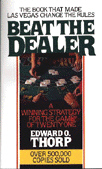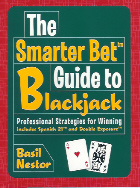
Beat the Dealer: A Winning Strategy for the Game of Twenty-One
by Edward Thorp
This great classic has sold half-million copies since the 1960s when it was originally published. Thorp is considered the 'Father of Modern Blackjack Play.' His theories helped develop a count system that revolutionized the way players and casinos look at the game. An absolute 5-star must for anyone who intends to play blackjack.

Smarter Bet Guide to Blackjack
by Basil Nestor
Strategy is the key to success at the blackjack table; that's a mathematical fact, and you can count on these expert, easy-to-learn tactics to make you a victor. Here's the deal: everything begins with the basic rules, and they're laid out on these pages with smart little “factoid” tips. Go through blackjack economics, which explain why cards fall the way they do, and what makes a good (and a sucker) bet. Easy-to-follow tables suggest strategies for splitting pairs and soft hands and provide dozens of other statistics and card probabilities.

How Blackjack Rule Variations Change Your Edge
Playing at a blackjack table with a single deck and favorable rules is getting harder and harder to do these days. After Edward Thorp in his book Beat the Dealer demonstrated that casinos had a pretty close game on their hands, they introduced a number counter-measures to get back their edge. In some cases where the changes were small, like going from one to two decks, players using basic blackjack strategy were wise to stick with it with no alteration. In cases were the changes were huge, like paying 6 to 5 on a blackjack instead of 3 to 2, the casinos created games that were only for suckers, and savvy players walked away.
When playing at a single-deck table where the dealer stands on soft 17 and doubling is allowed, but not after splitting, you are looking at a game where the chances of the house or the player winning are about even. When the casino alters that formula by adding decks and changing rules, the edge is changed. Let's look at some common deck and rule variations to see the effects on the player's odds. For example, if the player's odds are -1.0%, he or she will lose $1 per $100 wagered, on average.
Adding Decks
Two decks, -0.35%
Four decks, -0.52%
Six decks, -0.58%
Favorable Rules
Re-splitting Aces, +0.10%
Double after split, +0.13%
Late surrender, +0.15%
Dealer stands on all 17s, +0.20%
Double on more than two cards, +0.22%
Five-card automatic winner, +1.46%
Blackjack pays 2 to 1, +2.29%
Unfavorable Rules
Blackjack pays 1 to 1, -2.29%
Blackjack pays 6 to 5, -1.39%
Dealer hits soft 17, -0.20%
Double only on 10 or 11, -0.20%
No splitting of aces, -0.17%
Really Bad Rules (as calculated by the Wizard of Odds)
Player loses 17, 18 ties, -3.58%
Player loses 17-19 ties, -5.30%
Player loses 17-20 ties, -8.38%
Player loses 17-21 ties, -8.86%
You can use these percentages, both up and down, to calculate your odds at tables where there are deck and rule variations. Just remember to keep using basic strategy and stay away from the games with the worst rules. This is particularly true of single deck blackjack where the payoff is 6 to 5 or 1 to 1.
[ learn more blackjack! ]

